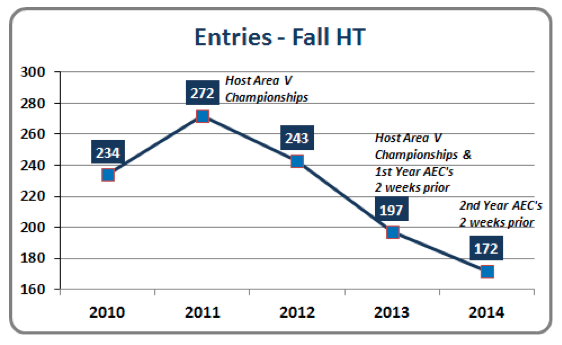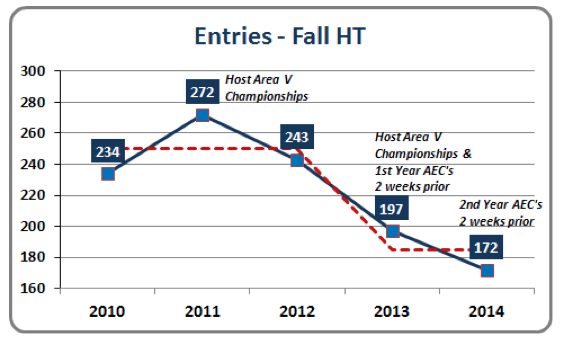We published a look at some of the dilemmas facing the American Eventing Championships earlier this month, and now Mary Hirsch returns with a detailed analysis of how holding the AECs at the Texas Rose Horse Park has impacted Greenwood Farm’s fall horse trials, held two weeks after the current AEC date. Many thanks to Mary for writing, and thanks for reading.

Angela Grzywinski and Make A Fuss at Greenwood Farm. Photo by Photon Hunt.
To date, most of the informal discussion around the future of the American Eventing Championships has focused on the riders, hashing through issues such as their length of travel, expenses, time off school and work, and more. But what about the impact of the AECs on the organizers, the people who make eventing possible by providing the facilities and hosting horse trials and events?
Other organizers, not only of the AEC host facility, as well have concerns and input into the AEC’s strategy for the future:
- How much of an impact have the AECs actually had on other area events, especially those running in the weeks after the AECs?
- Will this effect diminish over time, with entries returning to normal levels in the second and third year of the AECs in a given area?
USEA CEO Jo Whitehouse said last month in this EN post, “We need to be able to find a slot on the calendar that’s not going to impact the organizers of other events and that is within easy driving distance of everybody.” So how much impact on the other events is there?
Area V and Greenwood Farm Fall Horse Trials
With two years as the AECs host, a look at the numbers in Area V provides some objective data about the concerns of event organizers over entries at other horse trials. It would be best to look at all of the Area V horse trials, but of the larger horse trials running in the fall after the AECs, only Greenwood has entry information posted publicly on its website program archive, going back several years to provide enough data to observe trends.
So here’s a quick look at the entry data from the website for the Greenwood Farm Fall Horse Trials for the years 2010-2014, to allow a comparison with “normal” years. Greenwood can be expected to show the most impact of the Area V post AECs fall horse trials, as it runs just two weeks later, having given up its traditional calendar spot to the AECs.
First, some background: Greenwood is one of Area V’s oldest running fixtures, hosting two events each year in the spring and fall since 1996. Located just 20 minutes west of the Dallas-Fort Worth metropolitan area, Greenwood is one of the first in Area V to offer an Intermediate course. It was also the first to offer FEI one-star and two-star divisions (in the spring only).
Greenwood’s courses running through wooded paths and open meadows are an Area V mainstay for developing riders and horses. Both the spring and fall horse trials have consistently drawn about 250 entries, making them both among the largest horse trials in Area V.
Factors other than the AECs can influence entries, so here are some quick notes on major influences on entries at Greenwood’s fall horse trials in past years:
- 2011: Host for the Area V Championships
- 2013: Host for the Area V Championships, first year the AECs occurred two weeks beforehand
- 2014: Second year the AECs occurred two weeks beforehand

Below is the same graph with an added piece of data. The red-dash line represents the average entries from 2010 to 2012, then re-calculated for 2013 to 2014, the AEC years. From 2010 through 2012, the average entries for the fall horse trials was 250, but for 2013 to 2014, the average entries dropped 26 percent to 185.

Still got your geek on? Below is another graph, this one for left-brained number lovers! The chart below addresses these questions:
- How far are each year’s entries from the average number of entries before the AEC’s in Area V?
- Is there a consistent directional trend?
2010-2014 Greenwood Farm Fall Horse Trials Entries
% difference with pre-AEC average entries by year

The average uses only the years 2010-2012, before the Area V AECs.
Each year’s data point = entries calculated as a percentage above or below the average.

Formula for data points:
(Number Entries – Average) / Average = Percentage Above or Below Average
Of course, this is a sample size of one horse trials. To better determine trends and common causes across Area V and focus the picture of the possible influence of the AECs on Area V horse trials, it would be ideal to look at this type of analysis for all of the horse trials most likely to be affected and to explore any other possible causes of fluctuations.
All of the horse trials that follow the AECs in Area V within 175 miles of the Texas Rose Horse Park are Greenwood in Weatherford, Texas; Holly Hill in Benton, La.; MeadowCreek in Kosse, Texas; and Texas Rose itself, host of the AECs in Tyler, Texas, with Texas Rose’ final horse trials of the year in November. There are also others at a greater distance.
What people noticed at the 2014 Greenwood Fall H.T.
The Greenwood hospitality was welcoming as always. The fall horse trials are a bit lower key than the spring version, since only the spring has the FEI CIC* and CIC2* divisions. But traditionally the fall is well-attended, as riders take advantage of the course learning experiences and often prep for the Area V Championships when it is not Greenwood’s year to host them.
This year the decreased entries were noticeable in several ways. For the first time in the memory of many who attend regularly, there were two dressage rings, not three. Each day finished closer to 2 p.m. than 4 p.m. or later. Warm-up was less busy — not always a bad thing!
What do decreased entries mean financially?
Each of the Area V horse trials have different fees, but a look at the USEA Omnibus shows a general ballpark across the levels is about $220 entry and $140 stabling, which equals $350 per competitor as a rough estimate before other fees. Multiply this by any factor that causes a drop in entries of 20 to 30 percent and the reduction can add up to a corresponding drop in revenues from $8,700 to $17,500, per year, or more, conservatively.
Reducing costs? It’s no surprise that entry numbers are key for a horse trials to be successful financially. Once the cost is sunk into the courses and facilities, and there are enough entries to cover the basic expenses, each incremental entry brings more revenue with only minimal incremental cost. It’s a numbers game; the more entries, the greater the profit margin and the more worthwhile it is to continue hosting horse trials. But fewer entries make it that much harder to cover sunk costs and offer less compensation for the organizer’s ongoing time and effort.
When entries drop off, a crucial problem is that many other costs are not very flexible, and some are absolutely rigid. The cost of the course and the venue are substantially the same regardless of the number of entries. The basic core group of paid officials is needed, along with fees to sanctioning bodies, although perhaps some costs and judges can be eliminated by cutting extra dressage and show jumping rings. But an organizer may not be able to cut a partially occupied stabling tent if it would leave some horses out in the rain all night!
Vendors and Advertising: Vendors and advertisers are also keenly focused on the entry numbers — the more entries, the more attendees and the more sales, and the more exposure that leads to later sales. But from saddlery to art and sundries to the official photographer, this is another part of the horse trials where the cost of being there (and for the organizer to provide the space) is relatively inflexible. Fewer sales due to decreased attendance does not make the advertising and vendor space cheaper. But additional sales from more entries add revenue without much additional cost.
Profits: So the horse trial profit formula balances gross revenues from entries, advertising and vendor spaces against both the fixed and the sunk costs of putting on a horse trials — the courses, facilities, officials and more. Given these factors, a sudden drop in entries, and especially if the reasons for the drop are likely to continue, can cause a revenue shrinkage that makes the heavy and inflexible costs of the facilities more and more difficult to support.
The positives for the host area of the AECs
The benefits from the AECs for the host area may be harder to quantify in dollars when those benefits are more in the nature of “general good.” There is value in several good things that come to an area from the AECs:
- The host area riders will develop a greater awareness and more focus on the AECs as a goal for improvement.
- Course and other upgrades at the AEC facility are a benefit throughout the year for schooling and other horse trials.
- Exposure to high performers from other areas, at all levels low to high, is a great example for area riders of what can be achieved by other amateurs and juniors like themselves. This goes both ways: out-of-area riders learn more about areas outside their own.
- For the host community, other financial positives can be significant for hotels, restaurants, fuel and other sales that enjoy a brief but significant rush.
Where do we go from here?
The issues and worries of the organizers, as well as the short-term positives and long-term benefits, take a central place in the quest to make the AECs better for everyone. Balancing the wants and interests of the amateur and junior competitors with the opportunity to spread the word and grow eventing against finding ways to reduce the negatives that can happen when a major shift occurs in any area landscape are just some of the challenges facing the AECs today.
“If you want to build a ship, don’t herd people together to collect wood, and don’t assign them tasks and work, but rather teach them to long for the endless immensity of the sea.” — Antoine de Saint-Exupéry
























